1996 CADILLAC ELDORADO service
[x] Cancel search: servicePage 73 of 354
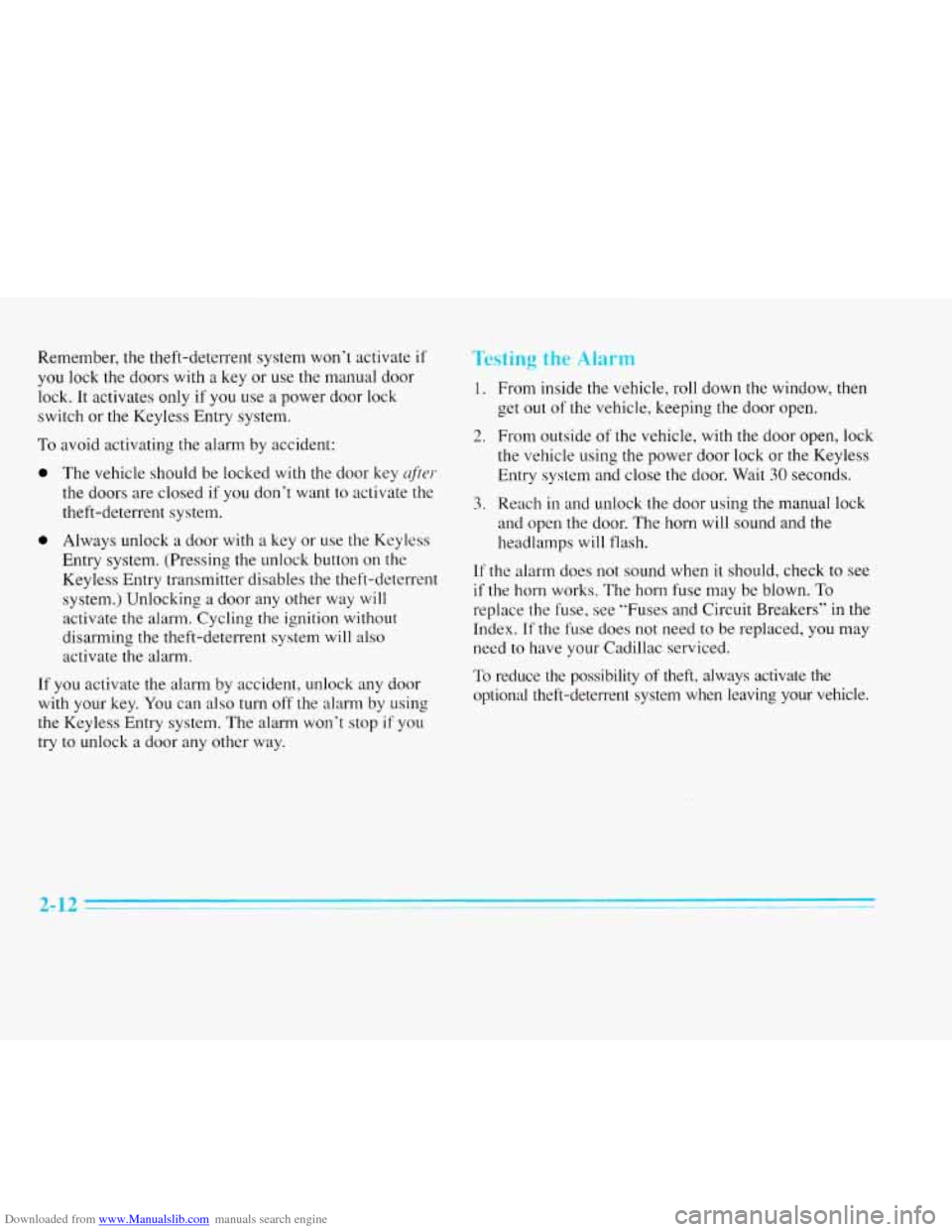
Downloaded from www.Manualslib.com manuals search engine Remember, the theft-deterrent system won’t activate if
you lock the doors with a key or use the manual door
lock. It activates only if you use
a power door lock
switch or the Keyless Entry system.
To avoid activating the alarm by accident:
0 The vehicle should be locked with the door key qfier
the doors are closed if you don’t want to activate the
theft-deterrent system.
0 Always unlock a door with a key or use the Keyless
Entry system. (Pressing the unlock button on the
Keyless Entry transmitter disables the theft-deterrent system.) Unlocking a door any other way will
activate
the alarm. Cycling the ignition without
disarming the theft-deterrent system will also
activate the alarm.
If you activate the alarm by accident, unlock any door
with your key. You can
also turn off the alarm by using
the Keyless Entry system. The alarm won’t stop if you
try to unlock a door any other way.
Testing the “Jarrr
1. From inside the vehicle, roll down the window, then
get out of the vehicle, keeping the door open.
2. From outside of the vehicle, with the door open, lock
the vehicle using the power door lock or the Keyless
Entry system and close the door. Wait
30 seconds.
3. Reach in and unlock the door using the manual lock
and open the door. The horn will sound and the
headlamps
will flash.
If
the alarm does not sound when it should, check to see
if the horn works. The horn fuse may be blown. To
replace the fuse, see “Fuses and Circuit Breakers’’
in the
Index.
If the fuse does not need to be replaced, you may
need to have your Cadillac serviced.
To reduce the possibility
of theft, always activate the
optional theft-deterrent system when leaving your vehicle.
2-12
Page 74 of 354
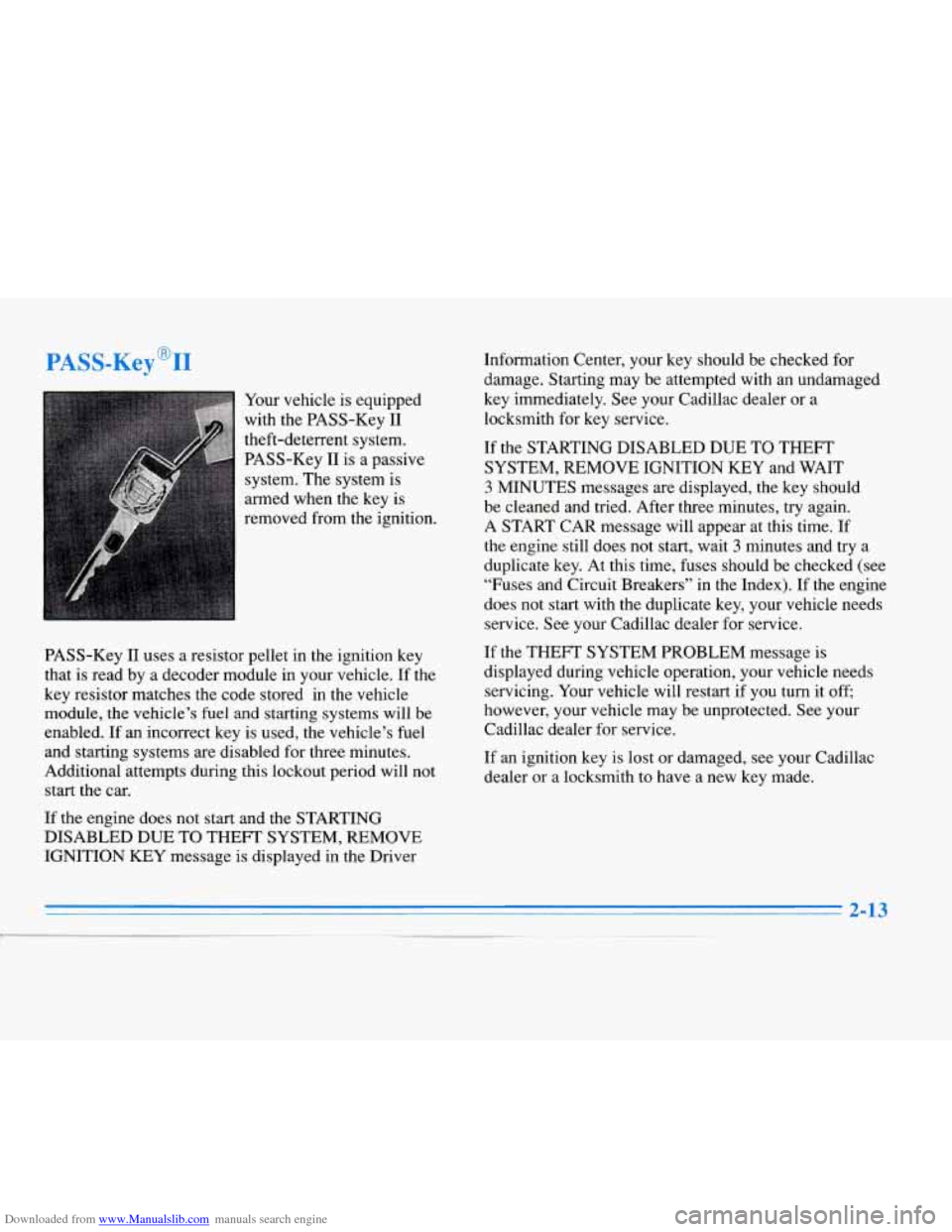
Downloaded from www.Manualslib.com manuals search engine ASS-k !yv 1
Your vehicle is equipped
with the PASS-Key
I1
theft-deterrent system.
PASS-Key
I1 is a passive
system. The system is
armed when the key is
removed from the ignition.
PASS-Key
I1 uses a resistor pellet in the ignition key
that is read by a decoder module in your vehicle. If the
key resistor matches the code stored in the vehicle
module, the vehicle’s fuel and starting systems will be
enabled. If an incorrect key is used, the vehicle’s fuel
and starting systems
are disabled for three minutes.
Additional attempts during this lockout period will not start the car.
If the engine does not start and the STARTING
DISABLED DUE
TO THEFT SYSTEM, REMOVE
IGNITION KEY message is displayed in the Driver Information Center, your
key should be checked for
damage. Starting may be attempted with an undamaged
key immediately. See your Cadillac dealer or a
locksmith for key service.
If the STARTING DISABLED DUE
TO THEFT
SYSTEM, REMOVE IGNITION KEY and WAIT
3 MINUTES messages are displayed, the key should
be cleaned and tried. After three minutes, try again.
A START CAR message will appear at this time.
If
the engine still does not start, wait 3 minutes and try a
duplicate key. At this time, fuses should be checked (see
“Fuses and Circuit Breakers’’ in the Index). If the engine
does not start with the duplicate key, your vehicle needs
service. See your Cadillac dealer for service.
If the THEFT SYSTEM PROBLEM message is
displayed during vehicle operation, your vehicle needs
servicing. Your vehicle will restart if you turn
it off,
however, your vehicle may be unprotected. See your
Cadillac dealer for service.
If an ignition key is lost or damaged, see your Cadillac
dealer or a locksmith to have a new key made.
Page 75 of 354
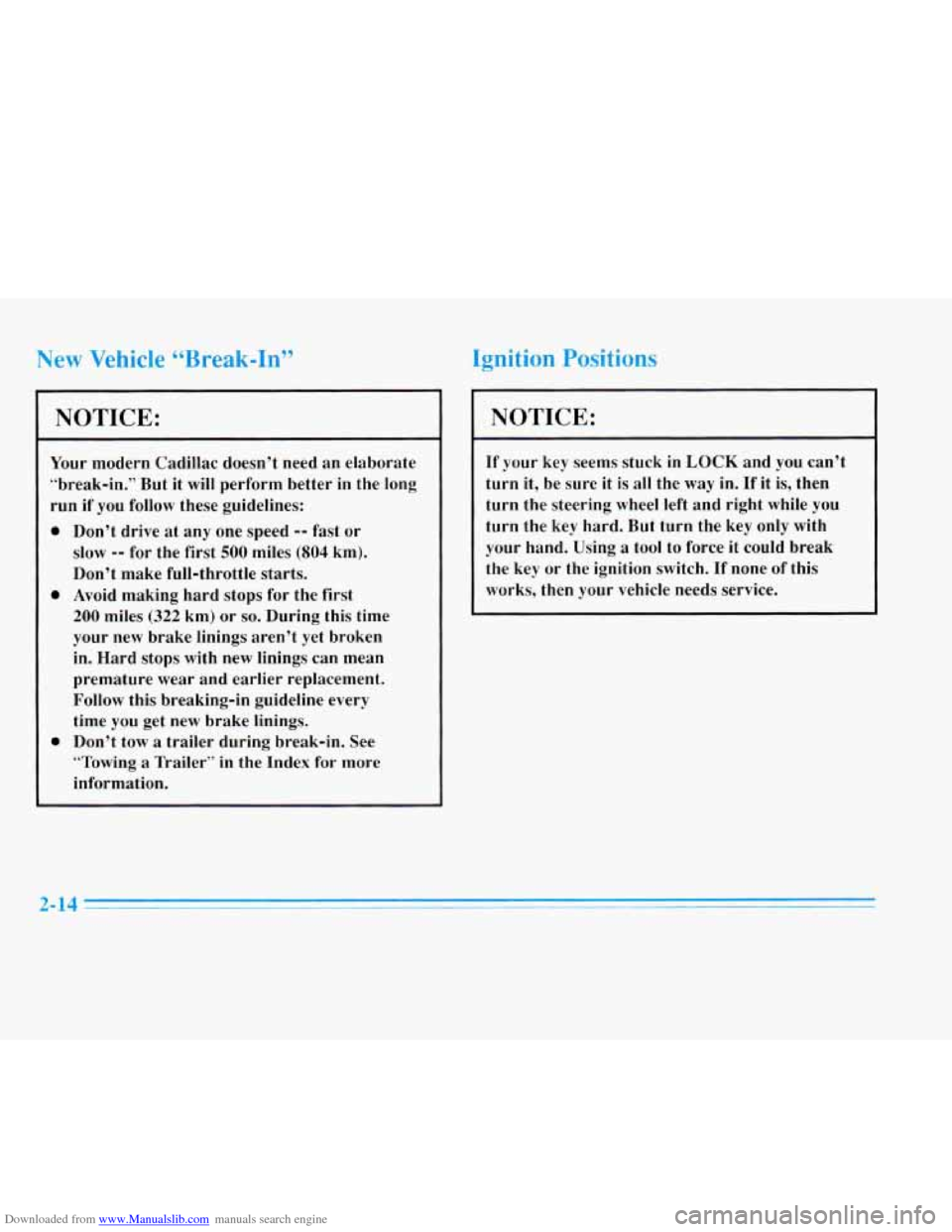
Downloaded from www.Manualslib.com manuals search engine New Vehicle L6Bre-ak-In’’ Ignition Positions
NOTICE:
Your modern Cadillac doesn’t need an elaborate
“break-in.” But it will perform better in the long
run if you follow these guidelines:
0 Don’t drive at any one speed -- fast or
slow
-- for the first 500 miles (804 km).
Don’t make full-throttle starts.
200 miles (322 km) or so. During this time
your new brake linings aren’t yet broken
in. Hard stops with new linings can mean
premature wear and earlier replacement.
Follow this breaking-in guideline every
time you get new brake linings.
0 Don’t tow a trailer during break-in. See
“Towing
a Trailer” in the Index for more
information.
0 Avoid making hard stops for the first
NOTICE:
If your key seems stuck in LOCK and you can’t
turn it, be sure it is
all the way in. If it is, then
turn the steering wheel left and right while you
turn the key hard. But turn the key only with
your hand. Using
a tool to force it could break
the key or the ignition switch. If none
of this
works, then your vehicle needs service.
2-14
Page 82 of 354
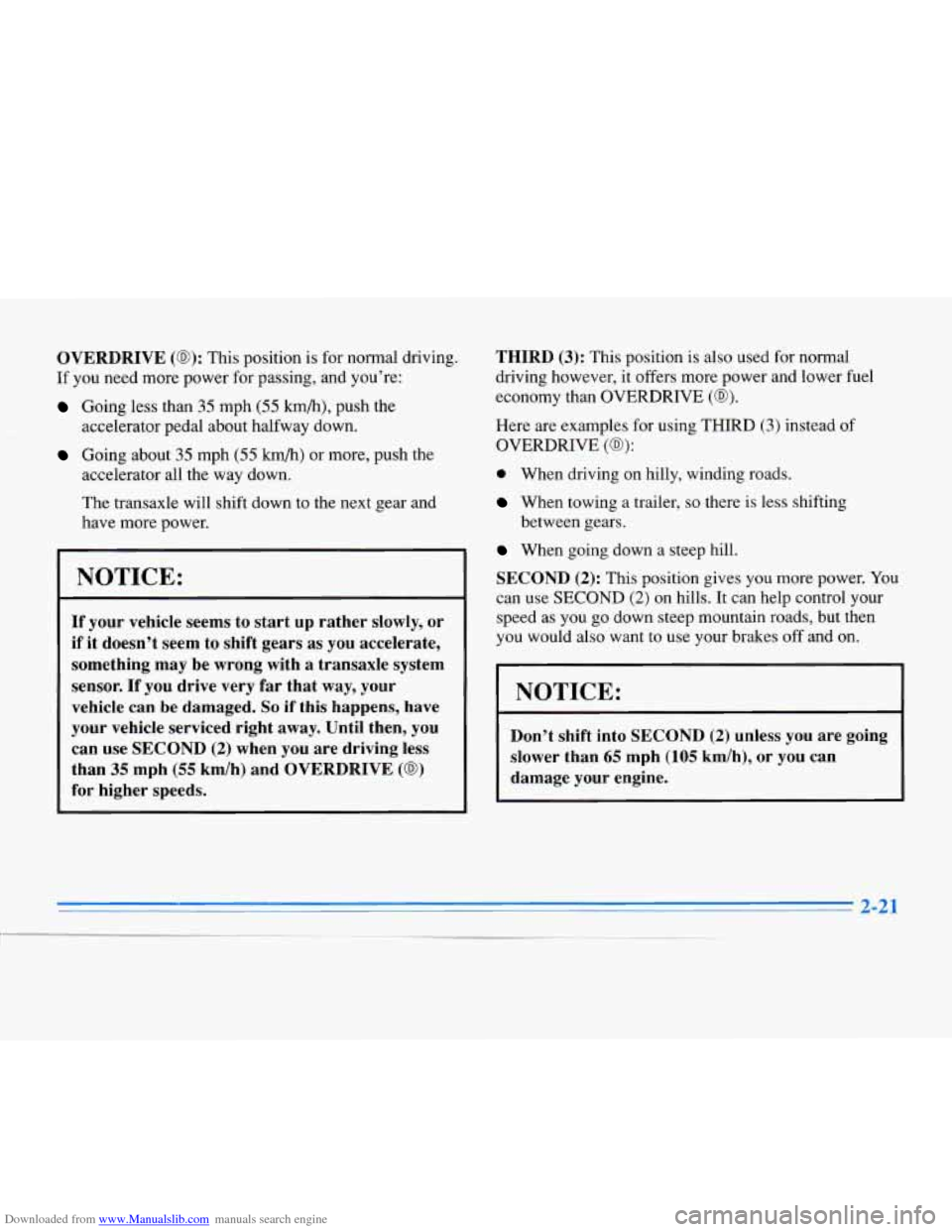
Downloaded from www.Manualslib.com manuals search engine OVERDRIVE (0): This position is for normal driving.
If you need more power for passing, and you’re:
Going less than 35 mph (55 km/h), push the
accelerator pedal about halfway down.
Going about 35 mph (55 km/h) or more, push the
accelerator all the way down.
The transaxle will shift down to the next gear and
have more power.
NOTICE:
If your vehicle seems to start up rather slowly, or
if it doesn’t seem to shift gears
as you accelerate,
something may be wrong with
a transaxle system
sensor. If
you drive very far that way, your
vehicle can be damaged.
So if this happens, have
your vehicle serviced right away. Until then, you
can use SECOND
(2) when you are driving less
than
35 mph (55 km/h) and OVERDRIVE (a)
for higher speeds. THIRD
(3): This
position is also used for noma
driving however, it offers more power and lower fuel
economy than OVERDRIVE
(03).
Here are examples for using THIRD (3) instead of
OVERDRIVE (03):
0 When driving on hilly, winding roads.
When towing a trailer, so there is less shifting
When going down a steep hill. between gears.
SECOND
(2): This position gives you more power. You
can use SECOND
(2) on hills. It can help control your
speed as you go down steep mountain roads, but then
you would also want
to use your brakes off and on.
I I
I NOTICE:
Don’t shift into SECOND (2) unless you are going
slower than
65 mph (105 km/h), or you can
damage your engine.
1
Page 84 of 354
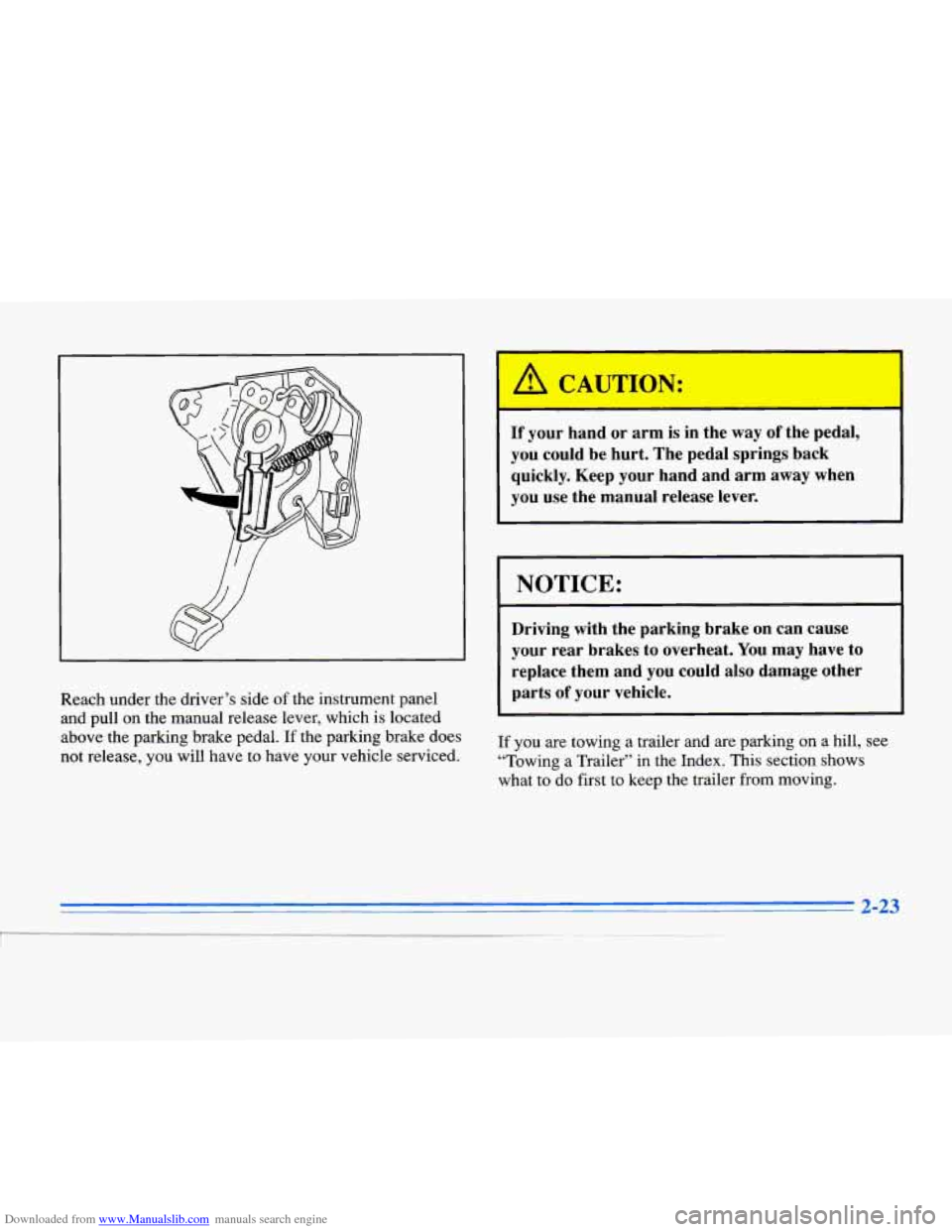
Downloaded from www.Manualslib.com manuals search engine Reach under the driver’s side of the instrument panel
and pull
on the manual release lever, which is located
above the parking brake pedal. If the parking brake does
not release, you will have to have your vehicle serviced.
A CAUTION:
-
If your hand or arm is in the way of the pedal,
you could be hurt. The pedal springs back quickly. Keep your hand and arm away when
you use the manual release lever.
NOTICE:
Driving with the parking brak6 bn’can cause
your rear brakes to overheat. You may have to
replace them and you could also damage other
parts
of your vehicle.
If you are towing a trailer and are parking on a hill, see
“Towing a Trailer’’ in the Index. This section shows
what to do first to keep the trailer from moving.
2-23
Page 125 of 354
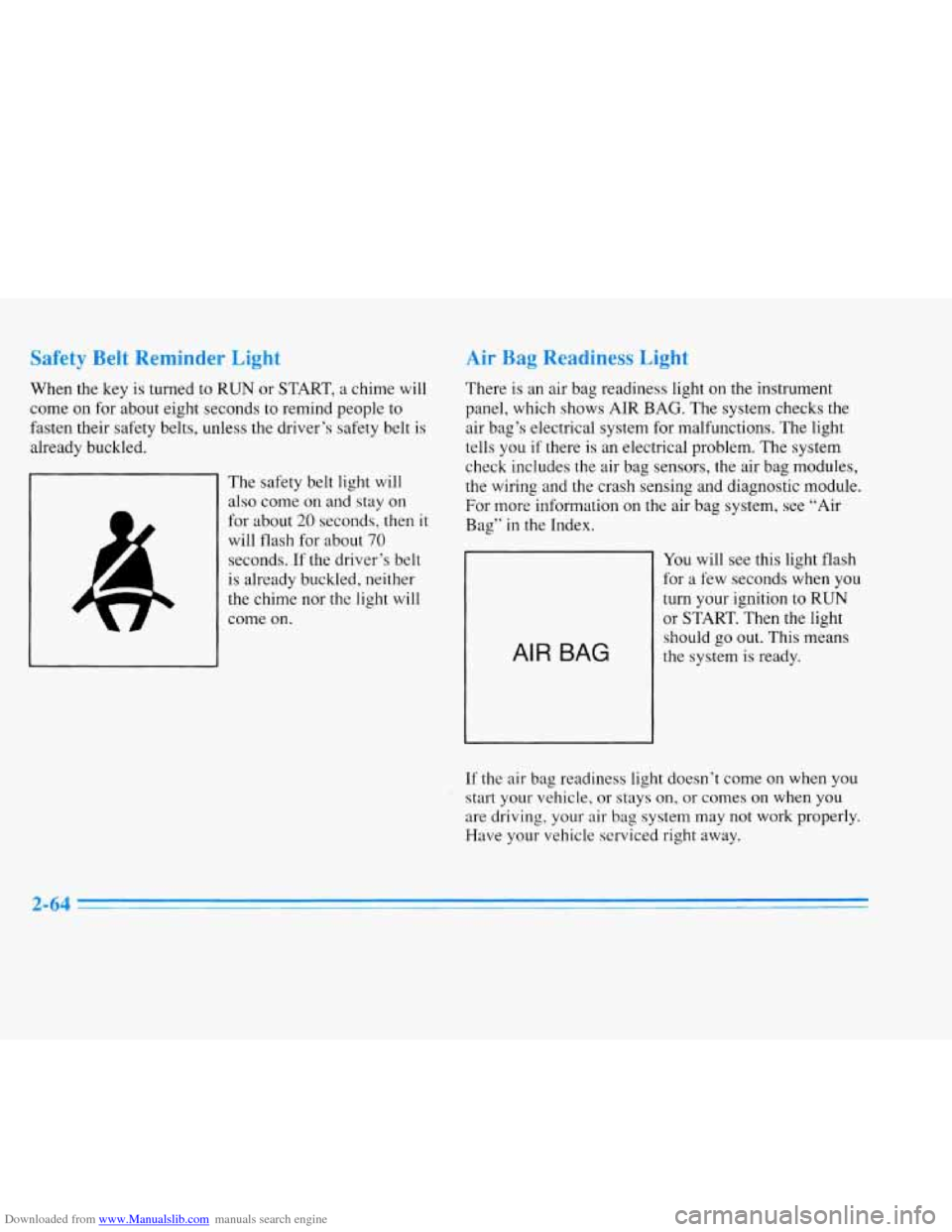
Downloaded from www.Manualslib.com manuals search engine Safety Belt Reminder Light
When the key is turned to RUN or START, a chime will
come on for about eight seconds to remind people to
fasten their safety belts, unless the driver’s safety belt is
already buckled.
The safety belt light will
also come on and stay
on
for about 20 seconds, then it
will flash for about 70
seconds. If the driver‘s belt
is already buckled, neither
the chime nor the light will
come
on.
Air Bag Readiness Light
There is an air bag readiness light on the instrument
panel, which shows AIR BAG. The system checks the
air bag’s electrical system for malfunctions. The light
tells you
if there is an electrical problem. The system
check includes the air bag sensors, the air bag modules,
the wiring and the crash sensing and diagnostic module.
For more information on the air bag system, see “Air
Bag”
in the Index.
AIR BAG
You will see this light flash
for a few seconds when you
turn your ignition to RUN
or START. Then the light
should
go out. This means
the system is ready.
If the air bag readiness light doesn’t come on when you
start your vehicle, or stays on, or comes
on when you
are driving, your air bag system may not
work properly.
Have your vehicle serviced right away.
2-64
Page 126 of 354
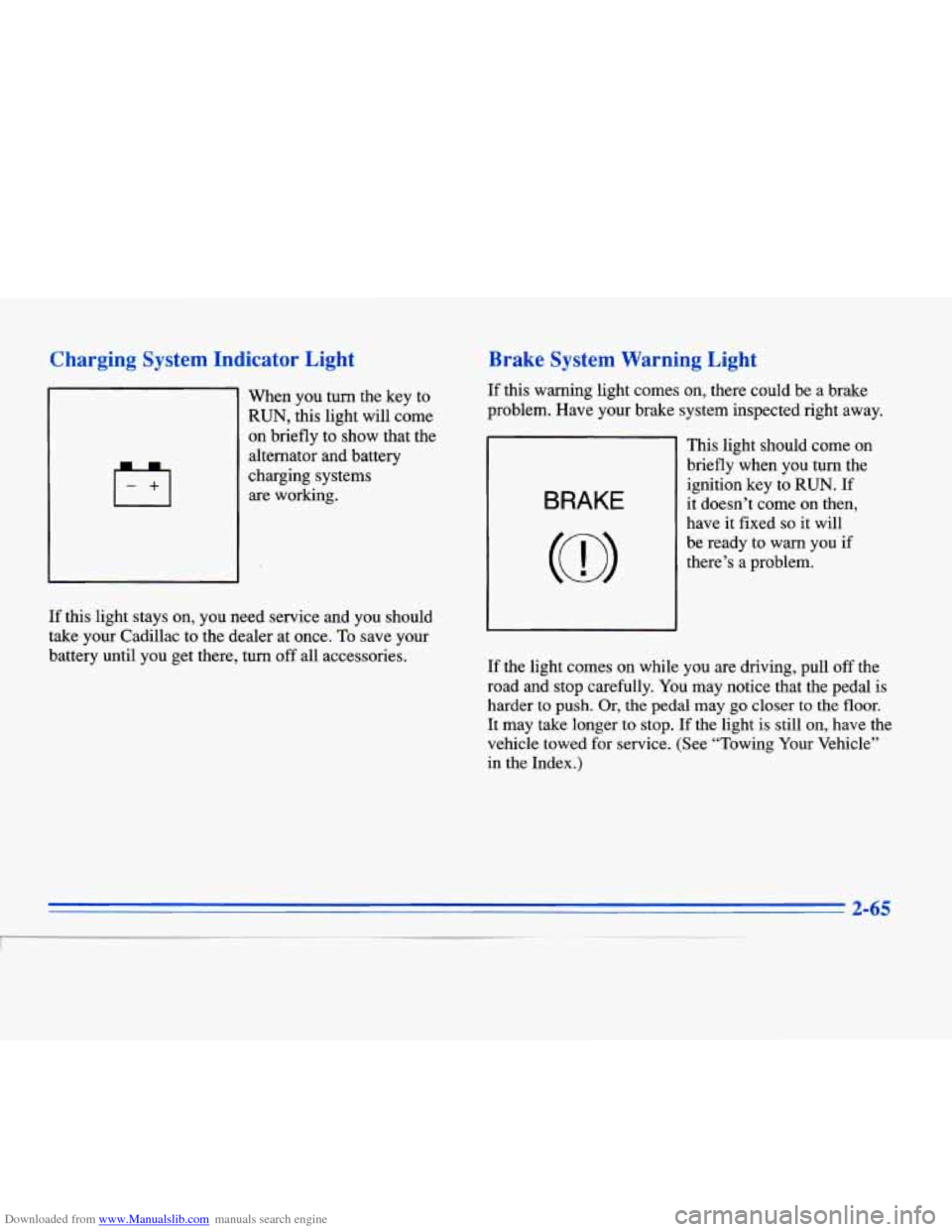
Downloaded from www.Manualslib.com manuals search engine Charging System Indicator Light
When you turn the key to
RUN, this light will come
on briefly to show that the
alternator and battery
charging systems are working.
Brake System Warning Light
If this warning light comes on, there could be a brake
problem. Have your brake system inspected right away.
BRAKE
This light should come on
briefly when you turn the
ignition key to
RUN. If
it doesn’t come on then,
have it fixed
so it will
be ready to warn you if
there’s a problem.
If this light stays on, you need service and you should
take your Cadillac to the dealer at once. To save your
battery until you get there, turn
off all accessories.
If the light comes on while you are driving, pull off the
road and stop carefully.
You may notice that the pedal is
harder
to push. Or, the pedal may go closer to the floor.
It may take longer to stop. If the light is still on, have the
vehicle towed for service. (See “Towing Your Vehicle”
in the Index.)
2-65
Page 127 of 354

Downloaded from www.Manualslib.com manuals search engine t
A CAUTION:
Your brake system may not be working.properly
'if the brake system warning light is on. Driving
with the brake system warning light on can lead
to an accident. If the light is still on after you've
pulled
off the road and stopped carefully, have
the vehicle towed for service.
1
When the ignition is on, the brake-system warning light
will
also come on when you set your parking brake. The
light will. stay
on if your parking brake doesn't release
fully.
If it stays on after your parking brake is fully
released,
it means you have a brake problem.
Parking Brake Indicator Light
PARK
BRAKE
This light come's on when
the parking brake is set, and
it will stay on if the parking
brake does not
fully release. ,.
If you try to drive off with
the parking brake set, this
light
will remain on.
This light should also come on briefly as you start the
vehicle. If it doesn't, have the light fiied so it will be
ready to remind you if the parking brake has not fwlly
released. For more information on how to release
the parking brake, see "Parking
Brake" earlier in
this section.
2-66